
Vaccinium is a common and widespread genus of shrubs or dwarf shrubs in the heath family (Ericaceae). The fruits of many species are eaten by humans and some are of commercial importance, including the cranberry, blueberry, bilberry (whortleberry), lingonberry (cowberry), and huckleberry. Like many other ericaceous plants, they are generally restricted to acidic soils.

Trillium erectum, the red trillium, also known as wake robin, purple trillium, bethroot, or stinking benjamin, is a species of flowering plant in the family Melanthiaceae. The plant takes its common name "wake robin" by analogy with the European robin, which has a red breast heralding spring. Likewise Trillium erectum is a spring ephemeral plant whose life-cycle is synchronized with that of the forests in which it lives. It is native to the eastern United States and eastern Canada from northern Georgia to Quebec and New Brunswick.

Gaylussacia is a genus of about fifty species of flowering plants in the family Ericaceae, native to the Americas, where they occur in eastern North America and in South America in the Andes and the mountains of southeastern Brazil. Common English names include huckleberry and "dangleberry".

Cardamine concatenata, the cutleaved toothwort, crow's toes, pepper root or purple-flowered toothwort, is a flowering plant in the family Brassicaceae. It is a perennial woodland wildflower native to eastern North America.

Trillium undulatum, commonly called painted trillium, painted lady, or trille ondulé in French, is a species of flowering plant in the bunchflower family Melanthiaceae. It is also known as smiling wake robin or striped wake-robin. The specific epithet undulatum means "wavy", which refers to the wavy edges of the flower petals. The plant is found from Ontario in the north to northern Georgia in the south and from Michigan in the west to Nova Scotia in the east.
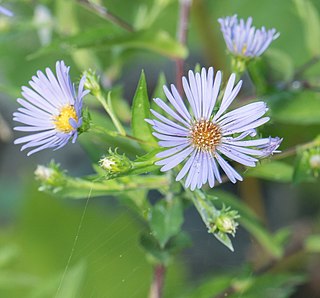
Symphyotrichum puniceum, is a species of flowering plant in the family Asteraceae native to eastern North America. It is commonly known as purplestem aster, red-stalk aster, red-stemmed aster, red-stem aster, and swamp aster. It also has been called early purple aster, cocash, swanweed, and meadow scabish.

Eutrochium purpureum, commonly known as purple Joe-Pye weed or sweetscented joe pye weed, is an herbaceous perennial plant in the family Asteraceae. It is native to eastern and central North America, from Ontario east to New Hampshire and south as far as Florida, Louisiana, and Oklahoma.
Eupatorium leucolepis, commonly called justiceweed or white-bracted thoroughwort, is a herbaceous perennial plant in the family Asteraceae native from the eastern coastal United States, from New York to eastern Texas, with scattered populations inland as far as Kentucky and West Virginia.

Stenanthium is a North American genus of flowering plants in the tribe Melanthieae of the family Melanthiaceae.
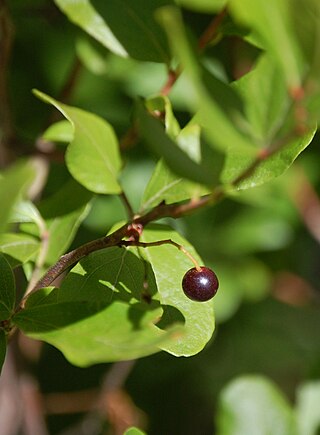
Gaylussacia baccata, the black huckleberry, is a common huckleberry found throughout a wide area of eastern North America.

Gaylussacia dumosa is a species of flowering plant in the heath family known by the common names dwarf huckleberry, bush huckleberry, and gopherberry. It is native to eastern North America from Newfoundland to Louisiana and Florida. It occurs along the coastal plain and in the mountains.

Gaylussacia frondosa is a species of flowering plant in the heath family known by the common names dangleberry and blue huckleberry. It is native to the eastern United States, where it occurs from New Hampshire to South Carolina.
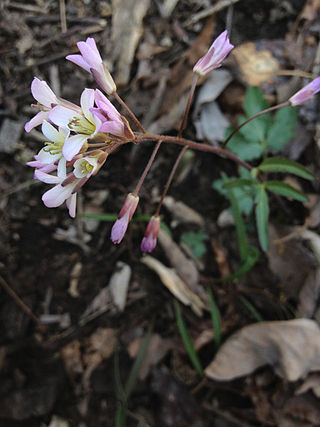
Cardamine angustata is a perennial forb native to the eastern United States, that produces white to pink or purple flowers in early spring.
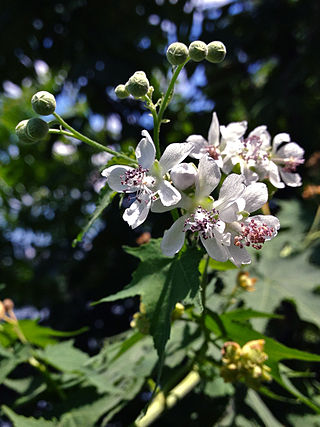
Sida hermaphrodita, known by the common names Virginia fanpetals and Virginia mallow, is a perennial forb native to the eastern United States, which produces white flowers in summer.
Arisaema pusillum is a species of flowering plant in the arum family Araceae. It is a member of the Arisaema triphyllum complex, a group of closely related taxa in eastern North America. The specific name pusillum, which means "very small, slender", describes the overall size of the plant relative to that of the more common Arisaema triphyllum. It is commonly known as the small Jack-in-the-pulpit. It is sometimes referred to as the swamp Jack, not to be confused with Arisaema stewardsonii, which is also known by that name.
Arisaema stewardsonii is a species of flowering plant in the arum family Araceae. It is a member of the Arisaema triphyllum complex, a group of closely related taxa in eastern North America. The specific name stewardsonii honors American botanist Stewardson Brown (1867–1921). It is commonly known as the bog Jack-in-the-pulpit. It is sometimes referred to as the swamp Jack-in-the-pulpit, not to be confused with Arisaema pusillum, which is also known by that name.
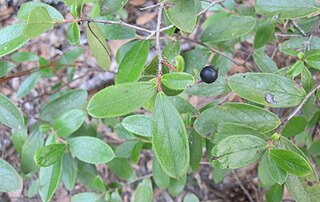
Gaylussacia mosieri, the hirsute huckleberry or woolly huckleberry, is a plant species native to the coastal plains of the southeastern United States.
Gaylussacia orocola, is a plant species native only to the southern Appalachians of western North Carolina. This plant grows only in Mountain Bogs, severely limiting available habitat. This plant has many common names which may be shared with other species. It is known to The North Carolina Natural Heritage Program as the Appalachian dwarf huckleberry and The North Carolina Botanical Garden knows it as the Blue Ridge bog huckleberry. It may also be referred to as the Gopherberry, Blue Ridge huckleberry, or Dwarf Huckleberry.

Quercus margarettae, the sand post oak or dwarf post oak, is a North American species of oak in the beech family. It is native to the southeastern and south-central United States from Virginia to Florida and west as far as Texas and Oklahoma. There are historical reports of the species growing in New York State, but it has not been seen there in years.
Cardamine dissecta is a species of flowering plant in the mustard family Brassicaceae.
















